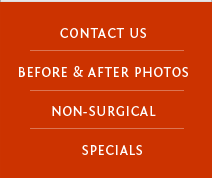Rhinoplasty, also called a nose job, is a surgical procedure designed to improve the appearance of the nose. There are as many different shapes of the nose as there are faces. They seem to go well with the face most of the time. However, there are situations where the nose is disproportionate in size and shape to the face. Most of the time this is an inherited trait; however, occasionally, a nose deformity may be acquired through trauma. The nose changes in shape and size with age as well. Depending on the original appearance of the nose, a minor change or major alteration may be necessary to obtain the desired balance.
How is Rhinoplasty Performed?
A nose job is performed under local anesthesia by numbing the area of the nose only. When more extensive work needs to be done, general anesthesia is recommended and the patient sleeps through the entire operation. During the procedure, you will be monitored by trained medical professionals who will ensure that you are comfortable and safe.
Reshaping the nose involves modifying the bone and cartilage. During a nose job, Dr. Kim makes a small, inconspicuous incision within the nostrils. When the nose is too large and there is too much volume, tissue is taken away. If the nose is too small or a deformity is due to volume deficiency, graft material may be used to enhance the volume. The usual choice of graft material includes cartilage and bone. For a major volume change, an implant may be used; this type of technique is called implant rhinoplasty. A combination of materials is often used to meet the need of the patient. Only a part of the nose, such as the tip, may be altered in tip rhinoplasty. If the wall dividing the two nostrils, called the septum, is crooked causing blockage of the nose, it may be corrected through a procedure known as septorhinoplasty.
Who is a Good Candidate for Rhinoplasty?
Individuals who are in good overall health with an appropriate degree of concern regarding the appearance of his/her nose will be happy with the improvement after surgery. The shape of the nose as perceived by the individual is very personal. It is possible to have a very slight deformity and yet be very obsessed with it. On the other hand, another person may have a very obvious deformity but show relatively little concern.
Recovering from Rhinoplasty
As with any operation, there is a recovery period during which there may be some discomfort. Swelling of the nose and bruising around the eyes is common, but should resolve in a week to 10 days. lf bone work has been done, the nose will be splinted on the outside for about a week to 10 days. In surgeries requiring less work, there may be no dressing. Any sutures will need to be removed within the first week. As is the case with many facial procedures, keeping the head elevated during recuperation helps settle the bruising and keep the swelling to a minimum.
Bleeding may be heavy at times. Infection is possible, but rare. Avoiding trauma to the nose in the early after-surgery period is important.
Rhinoplasty Results
After recovery, most people feel that the nose fits the face better and enjoy an improved overall appearance. Rhinoplasty often changes the look of the face considerably, while maintaining the identity of the individual. The nose will continue to change with age to a certain degree, but the improvement will be permanent.
Want to Know More About Rhinoplasty?
If you are interested in rhinoplasty procedures and/or rhinoplasty fees, contact our office by phone or email to receive more information or to schedule a consultation appointment.


